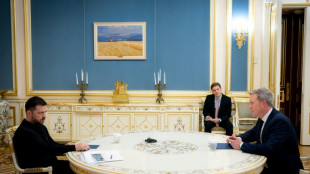
-
 Rubio lands in Geneva for talks on Ukraine plan
Rubio lands in Geneva for talks on Ukraine plan
-
Norris and Piastri disqualified from Las Vegas GP

-
 Slovenia holds crunch vote on contested assisted dying law
Slovenia holds crunch vote on contested assisted dying law
-
Aonishiki beomes first Ukrainian to win sumo tournament

-
 Holders Australia drawn with New Zealand in Rugby League World Cup
Holders Australia drawn with New Zealand in Rugby League World Cup
-
Vietnam flooding kills at least 90

-
 Muthusamy's maiden Test century powers South Africa to 428-7
Muthusamy's maiden Test century powers South Africa to 428-7
-
Myanmar junta says nearly 1,600 foreigners arrested in scam hub raids

-
 US signals room for negotiation on Ukraine plan ahead of talks
US signals room for negotiation on Ukraine plan ahead of talks
-
Verstappen wins Las Vegas F1 Grand Prix, Norris edges closer to crown

-
 Muthusamy anchors South Africa to 316-6 in second India Test
Muthusamy anchors South Africa to 316-6 in second India Test
-
Vietnam flood death toll rises to 90

-
 US denies pushing Russian 'wish list' as Ukraine plan
US denies pushing Russian 'wish list' as Ukraine plan
-
Harden's 55 leads Clippers win as Pistons streak hits 12

-
 Kim's first top-10 in 14 years as Ballester wins maiden pro title
Kim's first top-10 in 14 years as Ballester wins maiden pro title
-
Gotham crowned NWSL champions after Lavelle breaks Spirit

-
 Trump signals room for negotiation on Ukraine plan ahead of talks
Trump signals room for negotiation on Ukraine plan ahead of talks
-
Head shapes up as solution for Australia's opening woes

-
 Tomorrowland bets on Chinese dance music fans with first indoor event
Tomorrowland bets on Chinese dance music fans with first indoor event
-
England slammed as 'brainless' after first Ashes Test capitulation

-
 Slovenia to hold new vote on contested assisted dying law
Slovenia to hold new vote on contested assisted dying law
-
'Beer tastes better' for Eramsus after win over Irish

-
 No.1 Jeeno leads by six at LPGA Tour Championship
No.1 Jeeno leads by six at LPGA Tour Championship
-
Neres double fires Napoli top in Italy

-
 Bielle-Biarrey masterclass helps France hold off Australia
Bielle-Biarrey masterclass helps France hold off Australia
-
Pogba returns in Monaco loss as PSG stay top in France

-
 COP30: Key reactions to climate deal
COP30: Key reactions to climate deal
-
What did countries agree to at COP30?

-
 Harden's club-record 55 points leads Clippers over Hornets
Harden's club-record 55 points leads Clippers over Hornets
-
Amazon climate deal a 'win' for global unity but fossil fuels untouched

-
 Boos, blowups and last-minute pause as a chaotic COP30 closes out
Boos, blowups and last-minute pause as a chaotic COP30 closes out
-
Farrell proud of Ireland after 'mad' Test with South Africa

-
 Gaza civil defence says 21 killed in Israeli strikes
Gaza civil defence says 21 killed in Israeli strikes
-
South Africa beat ill-disciplined Irish to end Dublin drought

-
 South Africa's Marx named World Rugby player of the year
South Africa's Marx named World Rugby player of the year
-
Ukraine, US head for talks on Trump's plan to end war

-
 Newcastle dent Man City's title bid thanks to Barnes double
Newcastle dent Man City's title bid thanks to Barnes double
-
Brazil's Bolsonaro detained for trying to break ankle bracelet and flee

-
 Slot takes blame after Liverpool stunned by Forest
Slot takes blame after Liverpool stunned by Forest
-
Lampard hails 'outstanding' Coventry after comeback win over West Brom

-
 Thousands rally in France after murder linked to anti-drug activism
Thousands rally in France after murder linked to anti-drug activism
-
Geopolitical fractures and Ukraine worries sap G20 summit

-
 Robertson praises reshuffled All Blacks after Wales mauling
Robertson praises reshuffled All Blacks after Wales mauling
-
Spain to face Italy in Davis Cup final

-
 Ukraine, US to hold Geneva talks on Trump's plan to end war
Ukraine, US to hold Geneva talks on Trump's plan to end war
-
Lewandowski will remember scoring first goal at new Camp Nou 'forever'

-
 Thousands march in France to demand action on violence against women
Thousands march in France to demand action on violence against women
-
S.Africa G20 declaration highlights: minerals, debt, climate

-
 Barca thrash Athletic to inaugurate rebuilt Camp Nou in style
Barca thrash Athletic to inaugurate rebuilt Camp Nou in style
-
Forest beat Liverpool to add to English champions' woes


Rediscovering Iznik's lost art of vibrant Ottoman tilemaking
For over 300 years, the closely-guarded secrets of the Ottoman Empire's luminous tilework was lost, but its rediscovery has revived a key part of Turkey’s cultural heritage.
Renowned for intricate designs and lustrous colours, Iznik tiles are considered the pinnacle of Ottoman art, gracing monuments such as Istanbul's Blue Mosque and Topkapi Palace.
The tiles come from Iznik, a small town near Istanbul with a ceramics tradition spanning two millennia also known as Nicaea, which hosted a landmark Christian gathering in 325 AD that Pope Leo will celebrate when he visits this month.
Under the patronage of the Ottoman Empire, Iznik's artisans flourished, obtaining "remarkable achievements" by the mid-16th century, said Professor Ezgi Yalcinkaya, head of traditional Turkish arts at Usak University.
They developed a high-quartz stonepaste, known as fritware, yielding a bright white background ideal for decorating, transparent glazes and vibrant colours, including a "coral red" for floral designs which "created a distinctive new style", she told AFP.
But when the Ottoman Empire began to decline in the 17th century, the workshops started to close and the artisans, mainly Greeks and Armenians who knew the formula for the stonepaste, the colours and glazes, died off.
"Knowledge was passed entirely through master-apprentice relationships. The specific formulas -- especially for the coral red and fritware composition -- were oral secrets," she said.
"Without documentation, the expertise died with the last masters. By the 18th-19th centuries, the technical knowledge was largely lost."
Centuries later, an economics professor called Isil Akbaygil with a passion for Ottoman art set up the Iznik Foundation in 1993.
Her research project brought together experts and academics to rediscover the lost secrets of Iznik's prized ceramics.
- 'No recipe left' -
"What was forgotten about isn't so much the raw materials themselves as how they're combined... the firing temperatures and methods to achieve the distinctive coral red," said Kerim Akbaygil, a foundation board member and one of her sons.
"The foundation spent almost two years trying to get the right recipe, working with different universities like MIT, Princeton and Istanbul Technical University," he said.
"It was trial and error but we finally got it right," he told AFP at the foundation's headquarters, a rustic red-tiled building set in lush gardens lined with richly-coloured tile paths.
"Iznik tiles are the only tiles in the world that use up to 85 percent quartz which we use in the raw material along with clay and silica," he said.
They are underglazed with a high ratio of quartz giving them a "brightness and depth that are characteristic of Iznik tiles," he said.
Decorated with metal oxides whose colours are rendered vivid through the firing process, they are then coated with a quartz-based glaze known as "sur" -- Turkish for "secret".
- 'The beauty of surprise' -
Jars of colours -- from vibrant cobalt blues and emerald greens to coral reds -- line the shelves inside a large upper room where a dozen women sit painting tiles or transferring designs onto plain white tableware.
Many are painting an enormous mural for a train station -- one of the foundation's trademark commissions, its stunning tile facades a distinctive feature of the Istanbul metro and beyond.
Adding shadow to a giant fig leaf, Yasemin Sahin, 42, admits she's captivated by the transformation that occurs with firing.
"I'm painting this but I don't know what it will look like when it comes out of the kiln after it's glazed. It's always a surprise, that's the beauty of it," she told AFP.
Three decades on and Iznik tiles are now seen on buildings across Turkey, from colleges to coffee shops, with the foundation's international reach spreading form Japan to Canada.
"Back in the day, Iznik tiles were sponsored by the palace, so the only place you could see them was inside the palaces or mosques. Now that taboo is broken," Akbaygil says.
Yalcinkaya said the collective significance of rediscovering the lost formulas was "tremendous" and the result of extensive research by many academics and scholars.
"These efforts revived a living tradition," she told AFP.
"Ottoman ceramicists continuously innovated from the 14th-20th centuries. Today's work continues this spirit, ensuring the tradition remains alive and relevant, which is the most authentic way to preserve cultural heritage."
R.AbuNasser--SF-PST




